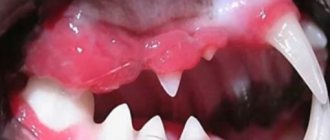Thanks to timely sterilization, you can not only get rid of mood swings and bloody spots during estrus, but also prevent the development of cancer in the future. Despite this, some owners refuse the operation in favor of breeding puppies.
Such a choice is completely justified, but sometimes for the sake of the pet’s health you have to put your desires on the back burner. Such situations include pyometra in dogs, which involves the mandatory removal of reproductive organs even in breeding animals.
What is pyometra?
An alternative name for the disease is purulent endometritis. It is an intrauterine inflammation accompanied by copious discharge of pus. Without timely assistance, tissues that are under increasing pressure rupture. In this case, the secretions accumulated inside enter the abdominal cavity and cause death from acute peritonitis.
Causes of pyometra in dogs
The risk group includes unsterilized pets over 5 years old. Especially those who regularly experience empty heats or, conversely, participate in matings too often.
The disease develops due to disruption of the reproductive system, caused by the following factors:
- A sharp jump in progesterone
. Its increase occurs in the period after ovulation. Under the influence of the hormone, the endometrium (the mucous layer lining the uterus) thickens, and the body's defenses weaken. An excess of cervical mucus occurs in the uterus, forming pathogenic microflora.
- Cysts, tumors, vaginitis and false pregnancies
. In these cases, pathology develops as a complication.
- Bacteria that entered the body during estrus
. Infection occurs in the absence of hygiene and without careful checking of mating partners. Infection from neighboring organs: the bladder and intestines is also possible.
- Hormonal contraceptives
, preventing unwanted pregnancy and changing the timing of estrus. Regular use of these drugs disrupts the natural level of hormones, provoking the development of inflammatory processes and cancer.
Very young animals that are overweight or have insufficient vitamins in their diet can also get sick. Only those who have had all their reproductive organs completely removed are protected from inflammation of the uterus.
Causes of pyometra
Pyometra can develop for many reasons, but the main one is a combination of hormonal changes that occur during puberty and a dog's heat. Each cycle causes the white cells of the uterus to naturally decrease to allow safe passage for sperm. For this purpose, the level of the body’s natural defenses is reduced, which does not allow the body to actively resist the attacking infection. For most dogs, estrus usually occurs twice a year, after which it is important to take a closer look at the animal's behavior.
Taking hormonal drugs, numerous false pregnancies or their complete absence, uncontrolled or completely absent matings can lead to the development of pyometra. Also, experienced veterinarians are of the opinion that poor nutrition, lack of nutrients in the body, insufficient care and harmful lifestyle of the animal indirectly contribute to the potential development of the disease.
Microorganisms that create inflammation can come from outside . For example, during estrus or in the process of non-compliance with sanitation conditions during childbirth, for example, getting from an insufficiently sterile bedding. Or the infection develops due to the animal’s own vaginal microflora. According to veterinarians, there is a certain risk group, which includes sexually mature individuals aged 4 to 8 years. Overweight dogs and other unsterilized female dogs are also more susceptible to developing pyometra.
Return to content
Symptoms and signs
The first warning signs include behavioral changes. The animal becomes lethargic and apathetic. It refuses to go for walks, eats poorly and drinks a lot. With a sedentary lifestyle and warm weather, this behavior is often ignored by the owners.
A gradually enlarging belly is also not a cause for concern. His growth is mistaken for pregnancy or weight gain.
The real excitement comes a little later, when the existing symptoms are complemented by:
- fluctuations in body temperature (a sharp jump to 40°C or a drop below normal);
- vomiting and diarrhea;
- acute pain when palpating the abdominal cavity, accompanied by whining, squealing or barking;
- swelling of the noose and frequent licking of the perineum;
- false urge to urinate;
- the appearance of foul-smelling discharge from the vulva of a strange color (green, gray, red) and consistency (flakes, thick mucus);
- cramps and muscle spasms that interfere with gait.
If any of these symptoms appear, you should be examined by a veterinarian. In some situations, emergency surgery may be required to save your pet, so you should not self-medicate until a diagnosis is made.
Types of disease
Symptoms of pyometra in dogs depend on the degree of dilatation of the cervix. If there is at least a small hole, pus flows freely out. This type of pathology is called open. It has well-defined symptoms and is easy to diagnose.
If the pus is tightly clogged inside, then its accumulation leads to swelling of the uterus and an enlargement of the abdomen. Other signs may be absent, so a sick animal is often taken to the veterinarian in serious condition.
This type is called closed. It is fraught with organ rupture and requires mandatory surgical intervention. Otherwise, death occurs within 2 hours after the release of pus into the abdominal cavity.
Metritis in dogs
Author: Victor Klinkov Category: Diseases and treatment
Metritis
is a pathology affecting the uterus.
As a rule, it is associated with the entry of various microorganisms into the organ cavity. We are talking about Staphylococcus aureus, Streptococcus, Corynebacteria, Escherichia coli, Pseudomonas aeruginosa, Clostridia, Mycoplasma. It is worth noting that the most common causative agent of metritis is E. coli. It is characterized by sensitivity to drugs such as aminoglycosides, chloramphenicol, ampicillin, and cephalosporins. Also often such a lesion is associated with staphylococcus. The cause of the most severe inflammatory lesion of the uterus is considered to be gas gangrene, as well as combined infections. Etiology
In females, the placenta, or rather its color and appearance, is important for metritis.
If the afterbirth is dark green or black in color, this indicates the presence of uteroverdine. This substance is a uterine pigment, the appearance of which is due to the processing of hemoglobin. Utheroverdine is evidence of inflammation of the placenta during pregnancy. The reason for this is considered to be contamination of the uterus during sexual intercourse, which is facilitated by purulent inflammation of the penis in males. In such cases, a timely fight against established metritis in the postpartum period is indicated. The following factors contribute to the development of metritis: 1. Unsatisfactory living conditions for the dog. 2. Poor nutrition of the animal. 3. Decreased functioning of the immune system. 4. Violation of rules during obstetrics. 5. Protracted nature of labor. 6. Delay in the release of the placenta. 7. Long stay of dead fetuses in the uterus. 8. Senile changes in the organ. Clinical picture of the disease
First of all, metritis in dogs manifests itself as severe depression.
Vomiting and increasing weakness are also possible. Pathological discharge with a foul odor is observed from the female genital tract. The animal is characterized by a decrease in appetite. The dog practically does not react to stimuli from the external environment. Palpation of the abdomen reveals tension and pain. Any of these symptoms is considered an indication to immediately call a doctor. Treatment
Treatment of metritis in dogs should be comprehensive. Therapy is influenced by the severity of the disease and the general condition of the animal. Among medications, antibacterial agents are primarily used. Their choice is influenced by the sensitivity of microorganisms isolated from the uterine cavity. If identification of the pathogen and determination of sensitivity to antimicrobial drugs is impossible, two or three antibiotics are used simultaneously. They must have a different spectrum of action. This is necessary for simultaneous effects on gram-positive and gram-negative microorganisms. It is worth noting that most often gentamicin, synthetic penicillins and cephalosporins are used for metritis in dogs. To cleanse the animal's body of microbes and their toxins, infusion and detoxification therapy is indicated. The use of antihistamines (suprastin) is also recommended. To increase specific immune defense, immunostimulants are prescribed. Drugs that help stimulate uterine contractility (oxytocin) are also indicated. An important step in the treatment of metritis in dogs is surgery. It involves removing the uterus. We are talking about a hysterectomy. This operation is necessary to remove the primary source of infection and prevent the development of sepsis.
- Dogs
- Pets
- illnesses
- metritis
March 24, 2017| 17:01
What is included in the diagnosis
Do not diagnose pyometra in dogs without the supervision of a veterinarian. Self-palpation of a swollen abdomen is fraught with damage to the walls of the uterus with subsequent eruption of its contents.
In addition to palpation, the diagnosis will require the results of the following studies:
- general and biochemical blood test;
- cytology smear from the vulva;
- ECG, ultrasound and x-ray of the pelvis.
After receiving the results, the doctor will be able to confirm the presence of pus and determine its amount. Further treatment will depend on the type of pathology.
Treatment of pyometra in dogs
In most cases, the problem can only be eliminated surgically. Drug therapy is only permissible for open endometritis, but even in this case there remains a risk of relapse. Veterinarians strongly recommend hysterectomy even for breeding animals, as repeated disease can lead to birth defects in their litter.
Drug therapy
Drug treatment for pyometra in dogs is effective in only 15% of cases. For a positive prognosis, you must be in good health. Otherwise, taking antibiotics that reduce immunity and hormonal drugs that stimulate uterine contractions can lead to the following consequences:
- exacerbation of chronic diseases due to a sharp drop in protective forces;
- the birth of puppies with congenital anomalies or the occurrence of miscarriages;
- development of infertility;
- rupture of the walls of the uterus, fraught with peritonitis;
- relapses occurring at the next estrus or shortly after it.
A weakened body does not survive anesthesia well, so another inflammation can be fatal even with an urgent operation. If your four-legged pet is not of breeding value and has a low degree of anesthetic risk at the time of treatment, then it is wiser to agree to surgical intervention.
Operating method
For pyometra in dogs, abdominal surgery is performed to remove all reproductive organs. Despite its similarity to castration, such surgery is much more expensive. The high price is explained by the difficulty of working with purulent contents.
If there is too much pus, the animal is prescribed hormones to stimulate at least partial release of exudate. Emergency surgery is indicated for closed endometritis, uterine rupture, the presence of tumors and cystic formations.
Possible complications include:
- negative reaction to surgical threads, suggesting repeated suturing;
- internal bleeding;
- state of shock due to a sharp drop in pressure (typical of a closed type of pathology);
- rupture of the uterine wall during the surgeon’s work with subsequent leakage of pus into the peritoneum.
Despite the risks, surgery is the only treatment that guarantees the absence of subsequent relapses. If you seek help in a timely manner, the prognosis is always positive. You should not be afraid of general anesthesia, since before using anesthesia your four-legged pet will definitely undergo a full examination.
Hygiene, care and diet
To protect the sutures from damage, a special bandage is put on the operated pet. Additionally, you can purchase a protective collar.
During the first 24 hours, she requires constant monitoring and care. Residues from the anesthetic impair coordination and may cause vomiting. For this reason, it is recommended to follow a fasting diet and avoid jumping on high surfaces.
Place a comfortable and warm place directly on the floor and make sure you drink enough fluids. Give water in small amounts to stay hydrated and prevent nausea. Return to feeding only after interest in food appears. Usually it occurs on the second day.
The food served should be warm and easily digestible. Before feeding, food must be cut into small pieces or mashed. For convenience, you can use ready-made dry food for sterilized animals or wet canned food. Chamomile infusion and vitamins prescribed by a veterinarian will help normalize digestion.
Treating the suture with special ointments, taking analgesics, laxatives and antibiotics are discussed before discharge from the hospital. In most cases, it is enough to monitor the cleanliness and condition of the postoperative wound. A small seal in this area is acceptable and will resolve on its own. You should only seek help in the following cases:
- fever and repeated vomiting;
- inflammation and divergence of sutures, fraught with infection;
- pallor of the mucous membranes, increased pulse and difficulty breathing, characteristic of internal bleeding;
- the occurrence of estrus, requiring repeated surgery.
If all recommendations are followed, recovery occurs within 3 weeks. The first positive changes can be seen already on the second day, but you should not rush and refuse to take the prescribed medications until you consult your doctor again.
Treatment of uterine inflammation in dogs
The main treatment process includes certain measures that are aimed at maximizing the elimination of the inflammatory process in the uterine area in a dog.
It is very important to limit the bitch from exposure to negative factors during treatment. Thus, if she is feeding puppies, then they urgently need to be switched to artificial feeding so that the mother’s body does not succumb to even greater stress. It is also very important to provide the animal with proper care and complete rest.
In order to maximize the contractile functions of the uterus, it is necessary to resort to the use of hormonal drugs.
The inflammatory process involves the presence of pathogenic microorganisms inside the walls of the uterus. Therefore, in order to suppress these pathogenic microbes as much as possible, the doctor prescribes therapy using antibiotics. Thus, drugs can be administered by injection, in tablet form, and also given to the animal in baths and douching. It is also very important to note that droppers and injections are most effective in combating pathogenic microorganisms.
Drugs that are introduced into the uterine cavity must be supported by medicinal stimulants. This is necessary so that microbes that are killed with antibiotics are quickly eliminated and do not remain in the pet’s body.
However, it is very important to understand here that traditional methods and local preparations do not provide very high effectiveness. Therefore, all these manipulations must be supported by internal antibacterial therapy. All medications must be taken by the pet strictly in accordance with the instructions or recommendation of the doctor. Self-medication is absolutely contraindicated here.
In the event that the inflammatory process develops catarrhally or catarrhal-purulently, then the therapeutic treatment method will bring the expected result. However, if your pet experiences uterine prolapse or other pathological processes, then surgery is recommended. This is due to the fact that with such a complex form there may be a different prognosis and development of events, and without timely intervention the animal may die.
The most drastic method is the removal of the reproductive organ. Removing the uterus allows you to avoid many complications and, in some cases, prolong the life of your pet. This is especially true in cases where there is a tumor of various etiologies in the uterine cavity.
After the organ is completely removed, its tissue is sent for histology in order to determine the presence of pathogenic cells and microorganisms. However, after such an operation is performed, the bitch will no longer be able to get pregnant, due to the absence of the main reproductive organ.
Therefore, if the bitch is used for breeding, complete removal of the uterus is recommended only as a last resort when other methods of treating the inflammatory process are not effective.
If we talk about homeopathic remedies, some veterinarians also resort to their use. These drugs are designed for long-term treatment and are used in a certain dosage. But, they are often used along with traditional techniques or after surgery, which significantly increases their effectiveness.










